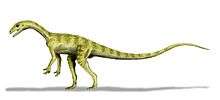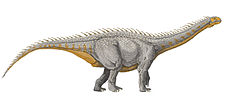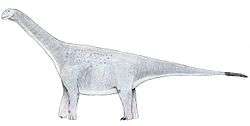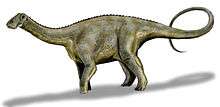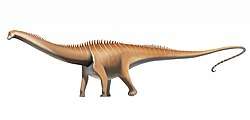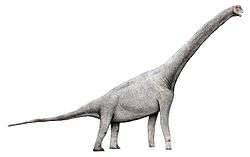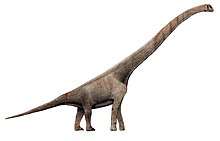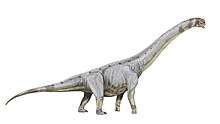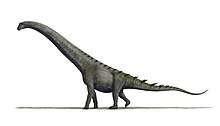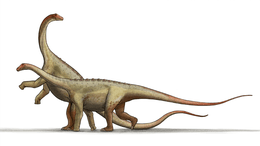Chiayusaurus
Chiayusaurus (meaning "Chia-yu-kuan lizard", after where it was found) was a genus of sauropod dinosaur known from teeth found in China and possibly also South Korea. Two species have been named for this obscure genus, although only the type, C. lacustris, is seen as valid today. It was originally named as Chiayüsaurus, but the ICZN does not permit special characters, so it has become Chiayusaurus. The old name can still be seen in older sources, though.
| Chiayusaurus | |
|---|---|
| Scientific classification | |
| Kingdom: | |
| Phylum: | |
| Class: | |
| Superorder: | |
| Order: | |
| Suborder: | |
| Infraorder: | |
| (unranked): | |
| Family: | |
| Genus: | †Chiayusaurus Bohlin, 1953 |
| Binomial name | |
| †Chiayusaurus lacustris Bohlin, 1953 | |
| Synonyms | |
| |
History and taxonomy
Birger Bohlin based Chiayusaurus on a tooth crown in the IVPP. This tooth was found in the ?Tithonian-age ?Upper Jurassic Keilozo (now Kalazha) Formation of Xinjiang, China. This spatulate tooth crown was 27 millimeters (1.1 inches) long, and was not unlike that of the younger genus Asiatosaurus.[1] As it was based on such sparse material, it has largely been ignored or considered to be indistinguishable from other, better-known sauropods. For example, Russell and Zheng found its tooth to be indistinguishable from those of Mamenchisaurus.[2]
Bohlin described a larger tooth in the 1953 publication as "Species A. (aff. Chiayüsaurus)", which he thought might belong to the type species.[1] In 1997, Lee, Yang, and Park described a new species from South Korea based on a tooth (KPE 8001) which they regarded as being identical to "Species A. (aff. Chiayüsaurus)". This new species, C. asianensis, is from the Aptian-Albian-age Lower Cretaceous Hasandong Formation of Namdo, Gyeongsang. The authors rejected the suggestion that Bohlin's two teeth may have differed from being in different places in the jaw, and separated their species on the basis of details of the wear surfaces and placement of ridges. The C. asianensis tooth crown is 46 mm (1.8 in) long.[3]
Both species were reviewed in 2002, by Barrett et al. They regarded the type tooth of C. lacustris as nearly identical to teeth of Euhelopus, but were unable to conclusively establish synonymy, finding it to be an indeterminate eusauropod. They found that C. lacustris and C. asianensis shared no special features, and instead differed. C. asianensis was regarded as a possible titanosauriform, but still indeterminate.[4] In the most recent review of sauropods, both species were considered to be dubious without comment.[5]
Paleobiology
As a sauropod, Chiayusaurus would have been a large, quadrupedal herbivore.[5]
References
- Bohlin, Birger (1953). "Fossil reptiles from Mongolia and Kansu". The Sino-Swedish Expedition Publication. 37 (6): 1–113.
- Russell, Dale A.; Z. Zheng (1993). "A large mamenchisaurid from the Junggar Basin, Xinjiang, People's Republic of China". Canadian Journal of Earth Sciences. 30 (10–11): 2082–2095. doi:10.1139/e93-180.
- Lee, Yuong-Nam; Seong-Young Yang; Eun-Jun Park (1997). "Sauropod dinosaur remains from the Gyeongsang Supergroup Korea". Paleontological Society of Korea, Special Publication. 2: 103–114.
- Barrett, Paul M.; Yoshikazu Hasegawa; Makoto Manabe; Shinji Isaji; Hiroshige Matsuoka (2002). "Sauropod dinosaurs from the Lower Cretaceous of eastern Asia: taxonomic and biogeographical implications". Palaeontology. 45 (6): 1197–1217. doi:10.1111/1475-4983.00282.
- Upchurch, Paul M.; Paul M. Barrett; Peter Dodson (2004). "Sauropoda". In Weishampel, David B.; Peter Dodson; Halszka Osmólska (eds.). The Dinosauria (2nd edition). Berkeley: University of California Press. pp. 259–322. ISBN 0-520-24209-2.
